Introduction
After General Guide To Leader Abilities In Gwent, we have moved into more detailed breakdown, faction-by-faction, following the alphabetical order:
Today we finish our journey with the youngest faction in Gwent: The Witcher Card Game – Syndicate. Each leader ability would be accompanied by a short characteristics, the most important synergies (importance rated with stars) and example decks.
All demo decks presented in the series could also be found in a Google Sheet.
Because of the unique mechanics of Syndicate, this chapter will start with a short preface.
Preface
Syndicate faction was introduced to Gwent: The Witcher Card Game in the Novigrad Expansion (June 2019). It is distinguished by own battle resource: Crowns (coins). Syndicate cards could gain coins or spend them to generate value.
Coins are an extra dimension to the game; a parallel world to store value and project it on the board when necessary via proper tools. All Syndicate leader abilities are related to this dimension in one way or another.
Therefore the comparison of leader abilities between Syndicate and other factions is not straightforward. Translating ‘coins’ into ‘points’ is not possible strictly and would differ for every deck, depend on meta etc.
Same coins may be used as proactive points, control (with cards like Philippa Eilhart, Moreelse, Whoreson’s Freak Show…) or utility (Kalkstein into purify…) Moreover, cards which convert coins to points in a good ratio would likely play below the curve until a couple of spends (Sea Jackal, Oxenfurt Guard…).
In this article I’d count leader coins to points as 1:1, while possible better converts would come from ‘synergy’. Consequently, to keep convention from earlier chapters, 8+ raw coins leader abilities would be called ‘pointslam’ in the description.
Blood Money

Blood Money is a control and synergistic leader ability (6 raw points). Due to passive part of the ability Blood Money is supposed to be run with at least a small bounty package. At initial power BM is underwhelming compared with leader abilities like Enslave, Precision Strike or Blaze of Glory. However at 8 damage (2 bounties activated), the ability power is already probably a bit better than Reckless Flurry; acceptable level. BM then is not necessarily dedicated to all-in bounty decks only.
- Flexible Removal *** | Blood Money with a couple of bounties gathered earlier has good removal reach compared with leaders like Enslave and unlike Blaze of Glory do not lose points when low power threats are the best target
- Extra Bounty Value *** | In Blood Money decks every bounty card is effectively worth +1 point, proven that Bounty could be gathered. Some cards like Caleb Menge or The Witchfinder have even higher potential because they could put bounty on one unit per turn. This gain especially matters in the case of Caleb, putting Bounty on 3 power unit suddenly gives net +1 point with respect to fee rather than net 0.
- Instant Bounty *** | Outside the passive, the active part of Blood Money also has elementary synergy with Bounty – it is possible to put bounty on a unit and kill in one turn.
- Bounty For Carryover *** | Bounty cards not only have higher effective value in BM, but this value is located on the leader ability and may be used as carryover in R1/R2. Natural Round 1 plan then involves gathering as many bounties as possible, while using only cheap cards. The bronze core of a BM deck should be Bounty themed, but the gold core not necessarily.
- Seizing The Initiative ** | Blood Money could get exceptional value in Round 1 engine skirmish. If round control is important, BM may be committed early and a part of its value may be regained later on thanks to passive.
- Pointslam Balance * | Blood Money builds should include cards which would help to win matchups where leader ability removal value is not high (pointslam opponents). Engine and pointslam directions are possible.
The tricky part about Blood Money deckbuilding is finding balance between removal tools, bounty markers, available coins and proactive spenders. In general, one removal is supposed to safely gather one bounty. To be safe, the number of bounties should never exceed effective removals (+1 if leader is also effective). Excess bounty likely results in a loss. Witch Hunter Executioner is the most flexible bronze card to conveniently gather bounties. With Hysteria/Slander, Exec alone could kill a unit with power up to 5. It is useful then to have a non-bounty source of coins in hand. Finally at least one proactive, full spender is needed to transform coins into points while not relying on opposing board state.
Demo decks:
- Blood Money All-in Bounty – A classical approach to Blood Money. The high-end is fully reliant on Bounty finding good value. Deck would often struggle to find proactive spender; that’s why Vivaldi Bank is run here to find Conjurer’s Candle just in case. Even with Candle (which may be destroyed too), spending coins could be troublesome, with high-end going very tall. Feel free to tune the list.
- Blood Money Golden Nekker – Golden Nekker provides top notch powerplay, which may be very efficient one turn removal (double poison) combined with engine overload. Blood Money GN is less conditional and prone to tall punish than all-in bounty, but nevertheless still may suffer a lot to spend coins without Candle.
- Blood Money KoB Brute – An example of rebuilt high end, a bit less focused on Bounty. King of Beggars and Jacques help to spend coins more conveniently in a short round.
Jackpot
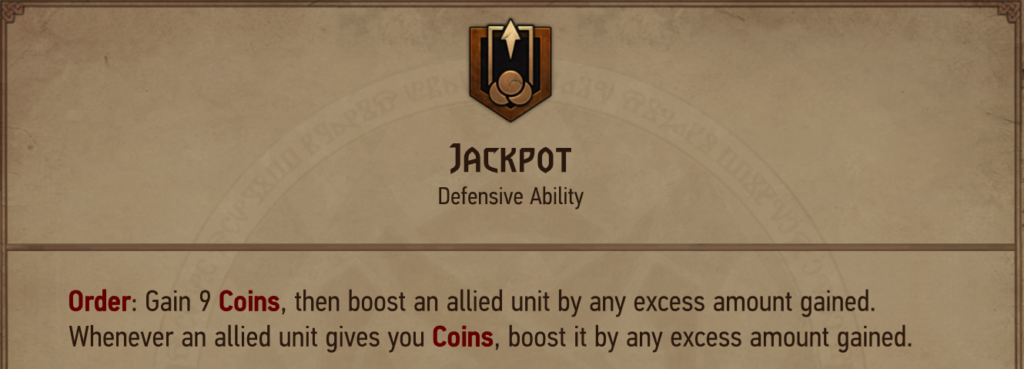
Jackpot is a ‘pointslam’ and synergistic leader ability (raw gain 9 coins).
- Overprofit To Value *** | Jackpot enables strategy and sequencing which leads to overprofits, proven that these are located on units. Examples of cards/synergies associated with overprofit: Captain Yago, Salamander + Roland, Sigi Reuven +10 with Caesar Bilzen, 1st form Saint Gregory…
- Protection By Overprofit *** | Units with profit get buffed when 9 coins limit is exceeded. Examples: Tax Collector, Imke…
- Active Protection ** | Active part of the leader ability may be used to protect a threat from removal.
- Instant Hoard ** | Jackpot active ability guarantees instant full poach for Hoard cards, no matter initial number of coins.
- King Of Beggars Deckbuff ** | Tribute play with KoB is resolved as follows: 1) Tribute is payed, 2) Tribute effect is triggered (for example Shady Vendor into profit crime), 3) Coins are returned with KoB. It could happen that the poach is already full when coins are returned – for example when Shady Vendor is played at 8 coins into a +4 coins crime. In such a case, thanks to Jackpot, returned coins are not wasted, but boost KoB inside the deck. Obviously this interaction do not bring any extra points, but could be used to keep KoB power for later on instead of committing to the current round.
- Count Reuven Treasure * | Jackpot passive works along with Count Reuven Treasure at full poach: both boost from Jackpot and extra counters on CRT are gained with extra coins. Excess coins then give +1 boost and +1 coin in the form of counters.. In an ideal world, CRT may for example turn Imke into effective ~+4 per turn engine In practice though, getting value from counters is troublesome and CRT itself is unstable. In the best scenario we get non-profit crime and 4 counters. If so, then at most ~+8 extra counters may be effective if the play is spread at 2 rounds (num of turns article). Also to get max possible value from counters, the pouch mustn’t be filled after first plays, which is anti-synergistic with other Jackpot perks.
Demo decks:
- Jackpot Devotion Yago – In Captain Yago deploy turn: 1) Poach should be full, 2) All coins are spent 3) Jackpot active ability is used, 4) All coins are spent again, 5) Yago comes in as 16 power (7 base + 9 Jackpot passive boost) + 9 coins. This version runs Jacques + King of Beggars for double spender; check also non-Devo version with Novigrad (from Murlytzo):
- Jackpot Salamander Rayla – Jackpot here is used to protect threats, both with passive and active part of the leader ability. If everything goes well, then Jackpot also prevents overprofit on Roland after Salamander deploy (from Kareem_Eid).
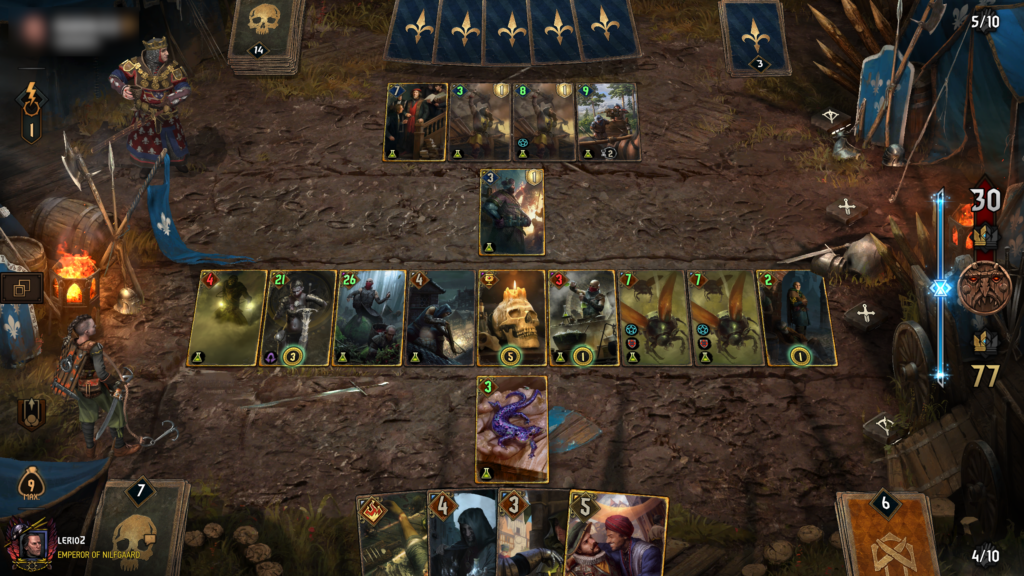
Lined Pockets
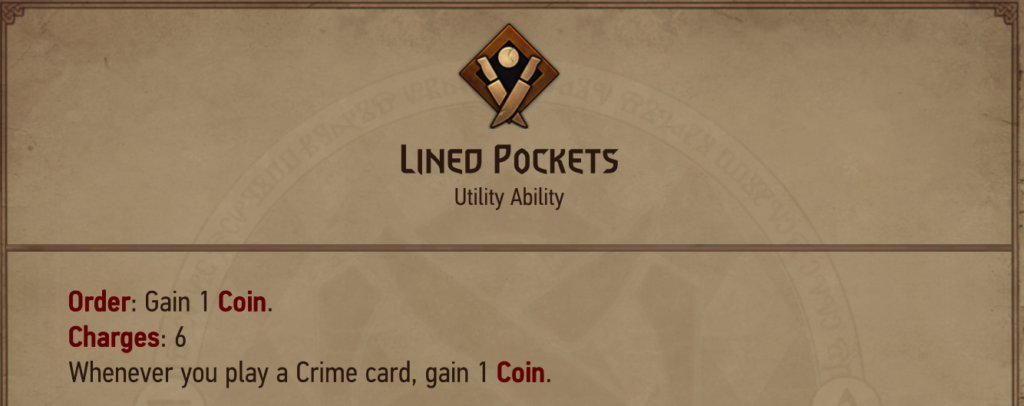
Lined Pockets is a synergistic leader ability (6 raw coins).
- Crimes *** | Lined Pockets gain +1 coin whenever a crime is played; potentially ~+12 coins in a full crimes deck. It could be compared with Nature’s Gift in Scoia’tael or Arachas Swarm in Monsters – if Crime cards are on meta level, then this leader ability is very strong, if crimes are very weak, then leader is hopeless (but due to other synergies still a bit better than Arachas Swarm / Nature’s Gift without cards activating their passive).
- Sesame *** | With a Fee:1 spender, Lined Pockets charges could be used to activate Open, Sesame! on Graveyard in one turn.
- Crime Spawning Units *** | Cards like Hemmelfart, Cleaver or Shady Vendors bring one extra coin under Lined Pockets due to Crime spawned.
- Townsfolk *** | With its charges, Lined Pockets could trigger Townsfolk 6 times, making it enter the game as 10p/6c (Gwent 11.11). Moreover, coins gained with passive also provide extra triggers.
- Coin Flexibility ** | Lined Pockets could setup Bloody Good Fun, Boris and other cards at exact number of coins when needed.
- Efficient Spenders ** | Lined Pockets generate more coins than any other Syndicate leader ability. Coins-to-points conversion rate is crucial for LP power; efficient high-end spenders multiply LP power.
Due to high coin output, Lined Pockets decks couldn’t rely on Crimes and its payoff cards only. LP deck has to conveniently deploy many spenders in a long round, which is lacking in pure crimes archetype. LP would often have to resort to ubiquitous spending support like Conjurer’s Candle or King of Beggars.
Demo decks:
- Lined Pockets Vice – ‘Sesame’ synergy is used to support Vice cards: Acherontia and Ixora.
- Lined Pockets Yennefer Cleaver – Cleaver is one of the most synergistic Lined Pockets cards – it plays a Crime, boosts from Crimes and is an efficient spender at the same time. In this deck Yennefer: Illusionist is a supporting card for Cleaver; potentially each first spawned Muscle may bring 6 damage from Yennefer.
- Lined Pockets Boris Casimir – Demo of ‘Coin Flexibility’. This deck runs Eveline Gallo, Boris and Casimiri Bassi which need precise coin management.
- Lined Pockets Poison Nekker Sesames – This deck demonstrates all Lined Pockets synergies, especially Oxenfurt Guard as efficient spender in a Golden Nekker deck.
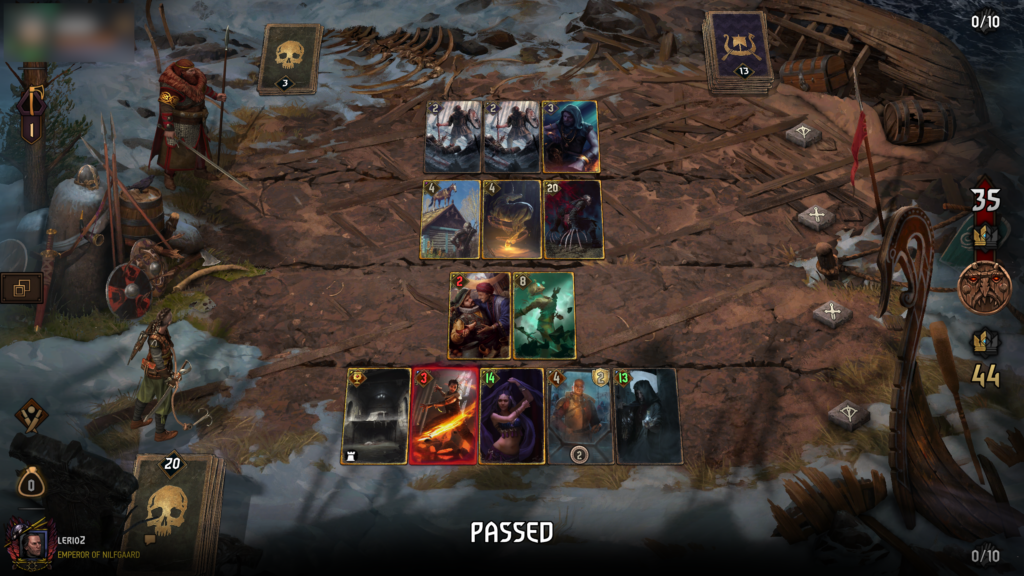
Off The Books
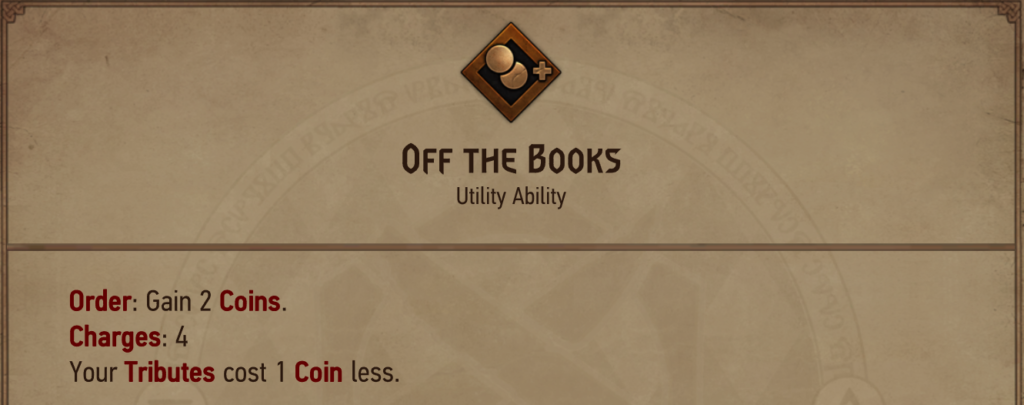
Off The Books is a mix of ‘pointslam’ and synergistic leader ability.
- Tributes *** | Compared with Lined Pockets+Crimes, Off the Books+Tributes support more high end gold cards. Also tribute themed card King Of Beggars is one of the main ways to make the deck scaling well into the short round and get guaranteed access to full spender.
- Coin Flexibility *** | Not as flexible as Lined Pockets, but Off The Books could adapt well with leader charges to achieve tactical objectives with the least possible commitment (for example one leader charge used to seize a unit with Philippa rather than full leader in Jackpot when facing the same situation).
- Sesame *** | Synergy similar to Lined Pockets, but weaker; couldn’t activate 6- counter Sesame in one turn, only 5-; sometimes uneven number of coins is a problem when lacking proper, 1-coin spender.
- Oxenfurt Guard ** | OtB has exceptional synergy with this bronze spender; at 0 initial coins each OtB charge is worth 4 points; 16 in total.
Demo Decks:
- Off The Books Vice – Compared with its Lined Pockets counterpart, OtB Vice loses less coins when using Shady Vendors for Open, Sesame! and generally has better peak performance, but sometimes would suffer from lower flexibility.
- Off The Books Devotion Gregory – Many decent Tribute cards are Firesworn: Jacques, Keeper of the Flame, Cleric Of The Flaming Rose. OtB Firesworn deck is more flexible than Congregate Devo builds; it is for example possible to play Moreelse as a tall punish and generate enough coins at demand.
Congregate
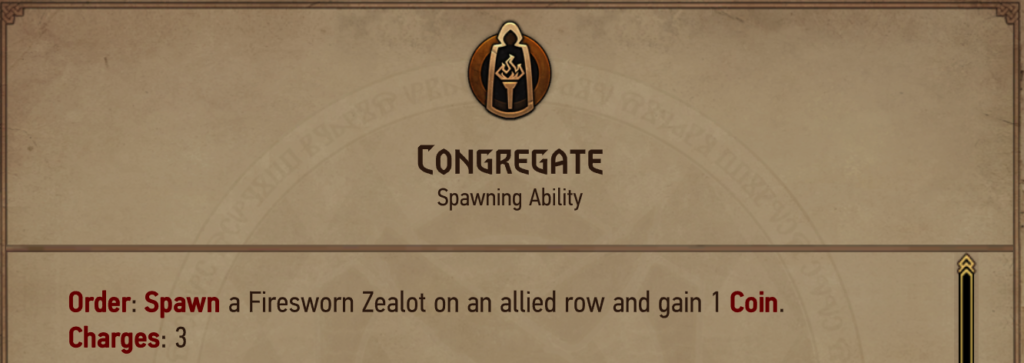
Congregate is a mix of ‘pointslam’ and synergistic leader ability (6 raw points + 3 coins).
- Firesworn *** | Congregate provides 3 Firesworn Zealots for archetype associated cards (Procession of Penance, Excommuncation, Saint Gregory…)
- Swarm *** | The Swarm aspect of Congregate is rather irrelevant outside Firesworn payoff cards, like Saint Gregory, Keeper of the Flame, Dies Irae, Sacred Flame… These cards are generally better with Congregate than the classical swarm counterparts (Bone Talisman, Yennefer of Vengerberg…).
- Whoreson Senior *** | Congregate conveniently provides both tokens and coins for immediate Whoreson Senior double transform. It opens a branch of Crime Congregate decks.
- Spawn ** | Zealots spawned by Congregate trigger engines like Fallen Knight or Firesworn Scribe.
Demo Decks:
- Congregate Devotion Firesworn – ‘Firesworn’, ‘Swarm’, ‘Spawn’.
- Congregate Whoreson Crimes – here Fallen Knights are usually used to win R1, while Whoreson Senior + leader is the opener for the decisive round, followed by Cleaver and Hemmelfart into Fallen Knight.
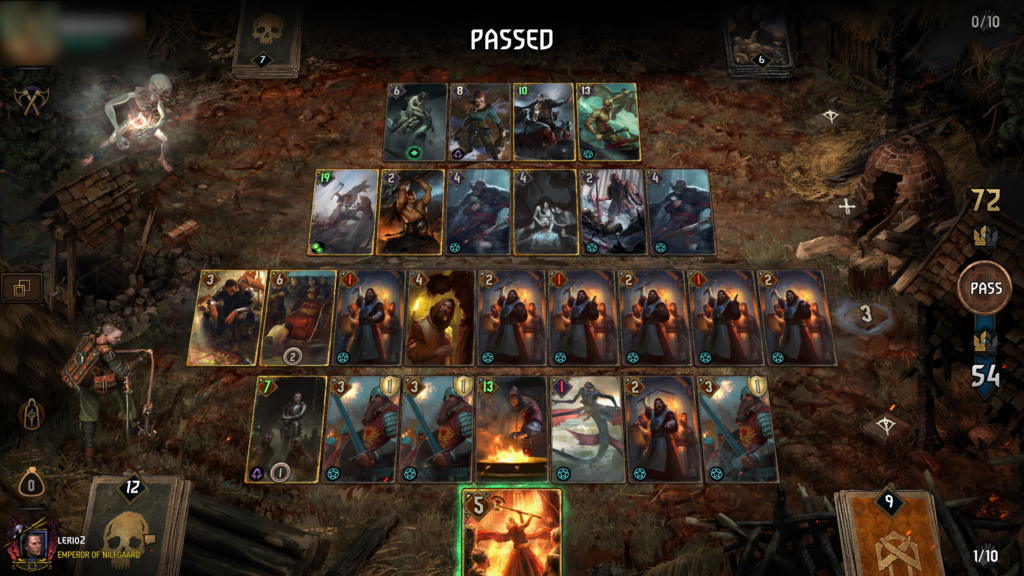
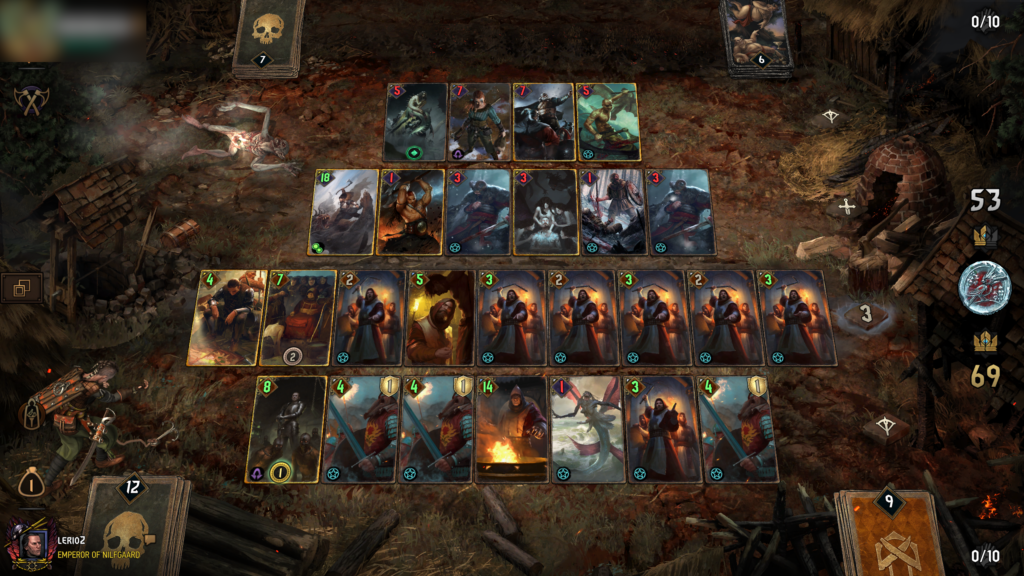
Pirate’s Cove
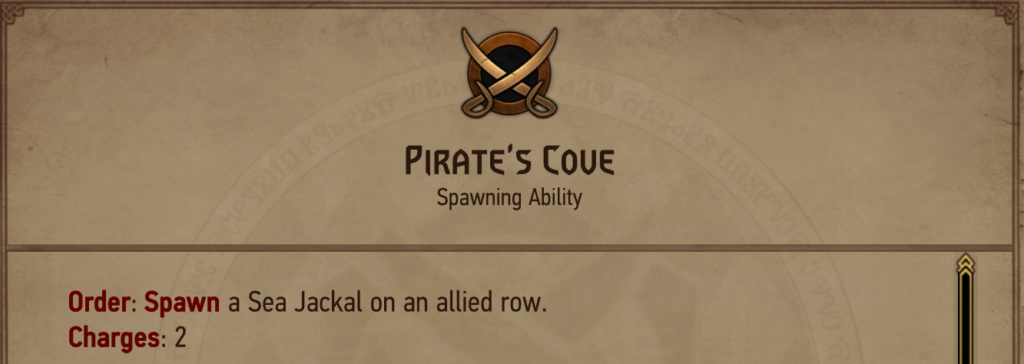
Pirate’s Cove is a ‘pointslam’ + synergistic leader ability (8 raw points). Pirate’s Cove is a unique leader ability in Syndicate, because it doesn’t provide any coins. Instead two charges spawning Sea Jackal – a spender with a Hoard effect – are available.
- Free Spenders *** | Pirate’s Cove decks could play less spenders than other leaders; they may be replaced with value cards instead.
- Tidecloaks Tag *** | Sea Jackals have precious Tidecloaks tag, which supports Gangs deck. It is possible to setup Collusion, Sigi: Mastermind, Pulling The Strings and Little Bird more convenienty
- Coin Rich Decks *** | Sea Jackals hoard effect works best with decks which generate plenty of coins.
- Damnation * | Very niche application – Pirates Cove may be used to setup Jackal at power proper for Damnation in the same turn. Target usually should be even provision cost.
Demo decks:
- Pirate’s Cove Gangs Collusion – ‘Tidecloaks Tag’. This version includes non-thematic cards which are strong in Gwent 11.11: Madam Serenity and Novigrad. Jacques, Cleaver or Hemmelfart are decent swaps. The deck also do not include Bart, who is designed to support Gangs, but lacks a tag himself and slows down Pulling The Strings or Little Birds. If you don’t want to play another devotion deck with Moreelse, feel free to swap him with Bart – deck still would be decent without direct tall punish.
- Pirate’s Cove Passiflora – Demo of ‘Free Spenders’ and ‘Coin Rich Decks’. Passiflora is not as convenient in Pirate’s Cove as in Hidden Cache, because without at least 4/3 coins at the start, follow up with Madam/Adriano is impossible. On the other hand, Sea Jackals reach huge values in this deck and help to smoothly trigger the 2nd chapter of Passiflora without losing coins.
- Pirate’s Cove Damnation Printing Press – While at the first glance one would expect Congregate to be the best host for Firesworn Scribes + Helveed + Lonely Champion ‘Printing Press’ combo, back in the days Myamon went for Pirate’s Cove. This leader ability spawns only one unit less than Congregate, but also provides spenders, which may be used to immediately set up Damnation. This synergy is so essential to get the combo going, that even Alissa Henson is run in order to replay Damnation.
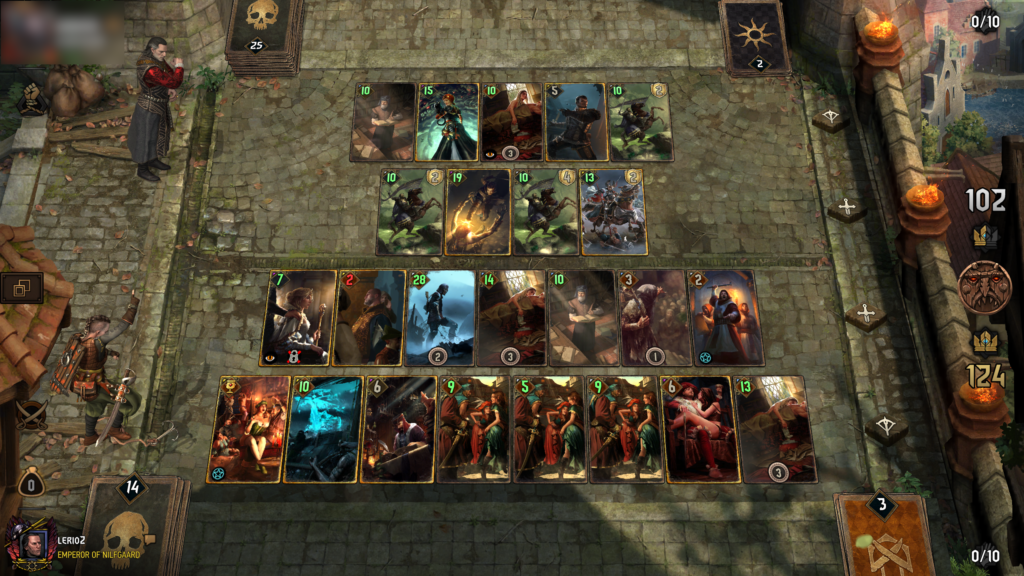
Hidden Cache
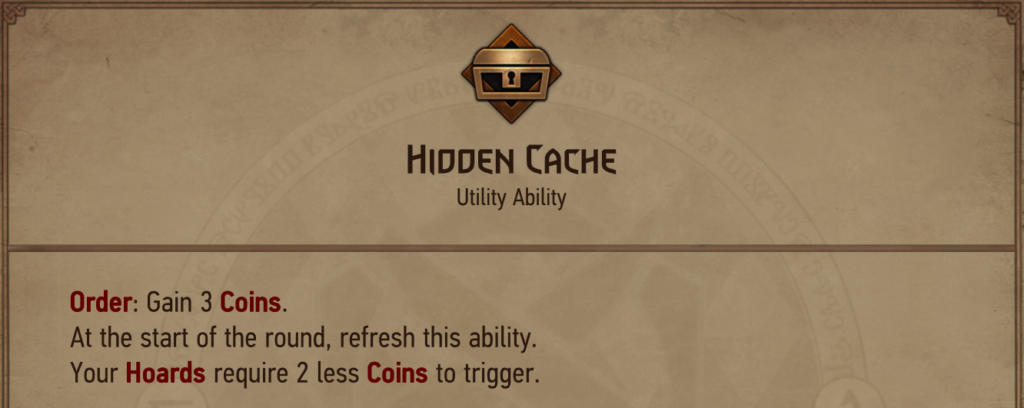
Hidden Cache is a ‘pointslam’ + synergistic leader ability (+3 raw coins per round).
- Hoard *** | Hidden Cache lowers the Hoard threshold. Unlike Lined Pockets + Crimes or Arachas Swarm + Organics, lowering threshold do not explicitly provide extra value on Hoard cards. There are two exceptions: Chapter 1 of In Search Of Forgotten Treasures and Sea Jackals. For other cards, lower Hoard value would mean more convenient use; often faster and less committal set up and more flexibility to spend coins without shutting Hoard effects down.
- Active Play *** | Hidden Cache value is spread between rounds. Taken as R3 leader alone, Hidden Cache is underwhelming: +3 coins leader with a small passive perk. HC then should try to get a strategic advantage from Round 1.
- Hoard Starter *** | In Round 1, when there is no initial carryover, +4 coins are needed to enable highest Hoard threshold cards like Saul de Navarette or The Flying Redanian. On blue coin, Tiger’s Eye stratagem is a perfect kickstart. On red, a coin generating engine is a logical start (Tax Collector, Imke or even Novigrad). In later rounds, HC would often opt to start with some coin carryover so that all hoard engines could be deployed faster.
Demo decks:
- Hidden Cache Forgotten Treasures – a demo deck which runs dedicated Hoard scenario: In Search Of Forgotten Treasures. Its 1st chapter combined with Flyndr’s Crew is usually strong enough to decide the outcome of a long round. The drawback is that scenario is very low tempo when defending bleed and often not so outstanding when R3 gets shortened. The best advantage HC could achieve in R1 is getting a tempo pass from blue coin. First say in Round 3 is generally better and also Flyndr’s Crew may be activated without need to shorten R3 and risk losing a card, which happens after R1 got won late.
- Hidden Cache Passiflora – Passiflora spawns Peaches, which is a Hoard card. +3 coins from Hidden Cache active ability may be useful to get instant follow up with tributed Madam Serenity.
- Hidden Cache Poison Nekker– Strong hoard cards: Hvitr and Aelydia, Saul de Navarette or The Flying Redanian are in Golden Nekker provision range and Hidden Cache makes their use more convenient.
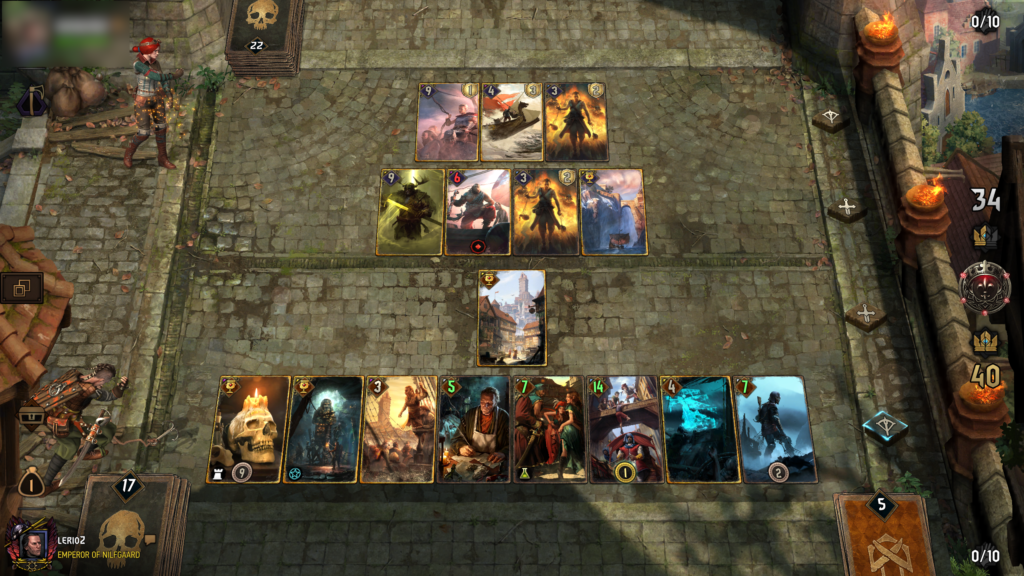
Closure
Hope you enjoyed this overview of Syndicate leader abilities and maybe would like to try some of presented decks/ideas yourself. Feedback is very welcomed; if you know about other decks/ideas making use of SY leader abilities, please let me know – I may update this article accordingly. Also if you tried any of demo lists from this or preceeding articles, feel free to share your thoughts and maybe spicy pics.
That was the last, final chapter of the Leader Abilities Guide cycle. The articles and decks would be constantly updated as much as possible – your feedback and ideas on what to add/change would be very welcomed.
All decks from the series could also be found in a Google Sheet.

